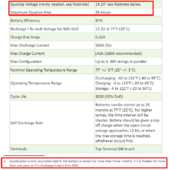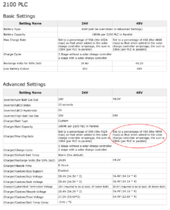Hi all.
I was going to start a new thread, but this thread subject is very close to my issue. Purchased a complete DIY system from the AltE store which was delivered December of 2021 and installed late summer of 2022 in my 100% off grid cabin in Northern Wisconsin and commissioned Labor Day weekend of that year. My system includes a pre wired CC/Switchgear/Inverter board, fairly common Midnite Solar Classic 150, Conext SW4048 with prewired switchgear in between those two components. Battery bank is (4) kilovault plc 2100s. Battery charging via (4) 375 watt mono panels wired series/parallel (2 strings of 2) panel output is 18.72 amps of 80.2 volts resulting in 1500 watts at peak.
100A max charge current recommended for those batteries, so you're well under that.
Full disclosure, due to inexperience, I did not meter the batteries upon delivery as I probably should have. Being delivered in December I had stored them in heated space (my home) until March
Better to store lead acid in cold temps provided there is no risk of freezing. Colder temperature further slows the loss of charge.
of the following year when I delivered them to my cabin and stored them there until time of installation that September. Never metered during that time.
Yeah. Not best practices.

All four batteries should have been charged and held at 14.1V until current dropped to about 2A.
I relied on the spec sheet write up with regard to storage life, as mentioned previously in this thread. Once everything was connected and fired up it all worked well through the end of November. I can't really recall what the readings were at various times of the day through that time period as it performed as expected through the end of November (deer season). At the end of that time period, I left the cabin, leaving the inverter and everything "on". I returned a week later (a week with no sun) to find the panels had accumulated 4" of snow. Inside the inverter had gone into "Low Battery Cut-Out". I believe it was set 43v or 42v.
42V is a very common cut off as this corresponds to 10.5V/12V battery = depleted.
At that time I metered the batteries and found 3 of them to be in the low 11s and one just over 9 volts.
Pretty imbalanced. The 11s had a measurable amount of charge, but the 9V was beyond empty.
At that time I shut the system down, loaded up the batteries, took them home, placed in heated space
25°C is optimal.
and slow charged individually
Very much not a good idea. lead acid needs to be charged at a minimum value to prevent forced sulfation during charge. The absolute lowest charge rate for batteries of this size would be 9A, and that's the minimum charge rate referenced in the manual.
monitoring/recording the soc on each several times a week until spring of the following year. After full charges, SOC held steady on all 4 "at rest" batteries at around 12.7v.
12.7V is a little low for fully charged AGM.
Reinstalled the batteries and fired the system up in March of '23. The system performed as expected through summer and then things started to downgrade with 3 of the batteries holding a consistent equal charge among them and equal discharge rate, and what I am assuming is the battery that was discharged down to 9 volts will not charge above 11.5v and seems to discharge rapidly thus dragging down the rest of the system. For example, minimal load, intermittent use of a couple LED lights, phone charger, and of course the draw of the inverter itself, fairly quickly brings the cumulative battery level down below 48v. As read previously, that value is not necessarily alarming but this is less than an hour after loss of sun exposure and not applying any other largish loads such as the micro wave. Anything over say 5 amps, even momentary, will draw me down below my current LCBO setting of 47 volts. I realize I can safely set that lower but this performance does not seem as it should be and getting noticeably worse.
So after the long-winded background, my questions would be:
1. Is it reasonable to assume that I have a "bad" battery?
Did you at any time, when you were charging to 56.4V confirm that all 4 12V were at 14.1V?
Is your charger temperature compensated?
2. Can I run an equalization charge on just this battery? (this was recommended by AltE tech support, as well as a local solar installer)
Equalization is just an extended absorption charge. Per the manual:

You meet two of three of the criteria.
3. Can I "mix" in a different (brand name) battery that would have similar parameters as the 3 plc 2100s that seem to be working?
Yes, but this usually doesn't work as well as using the same brand, particularly with these specialized AGM. It is VERY rare for a 180Ah AGM to be able to tolerate 100A of charge current. MOST AGM want to be charged to much higher than 14.1V, and most AGM have much less than 3000 cycle life with 50% DoD.
4. Should I just go with a completely new battery bank?
Maybe. I would personally put all four in parallel and hold at 14.1V for 24 hours. Then string in series and re-assess regular logging of individual 12V voltage throughout the operating range.
5. If new bank, any suggestions/posative reviews? Due to temperature considerations, I cannot do Lithium. We regularly have ambient overnight temps well below zero in winter. This facility is not heated 24/7/365. I would like to stay 180-200 ah. and AGM type.
These are great batteries. IMHO, you likely set them up for failure in not following best practices in initial storage, installation and poor monitoring. Repeat the same on any other brand, and you will find yourself here again.
Your "preference" for 180-200ah should be driven by ONE criterion - how much energy do you use per day. I assume your probably thinking more about portability and weight management - important but secondary. 180-200Ah of batteries can only deliver about 4.8kWh/day. This means you can't use more than that, and that's not very much.
- Lead acid batteries can only deliver about 50% of their capacity between charges without reduced cycle life.
- Lead acid batteries need to be fully charged as often as possible - daily is preferred.
- They must actually meet the fully charged criteria, i.e., in your case, they are fully charged when the bank is at 56.4V, each is at 14.1V and the current has dropped to 1.8A or lower. Failure to get to this point means the batteries are not fully charged and life will be reduced.
- They must be charged with temperature compensation if not in a constant 25°C environment. Colder than 25 and batteries need to be charged to HIGHER voltages. Higher than 25 and batteries need to be charged to LOWER voltages. Failure to use temperature compensation will reduce battery life.






